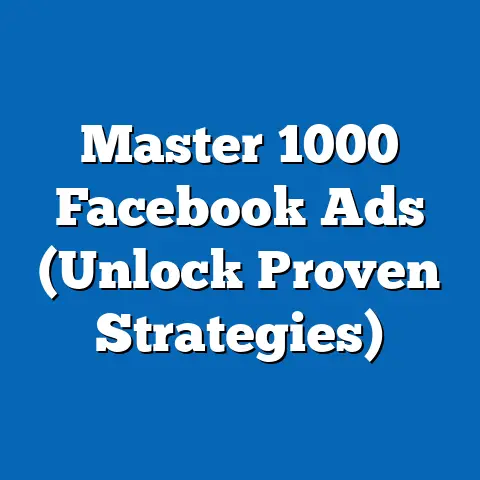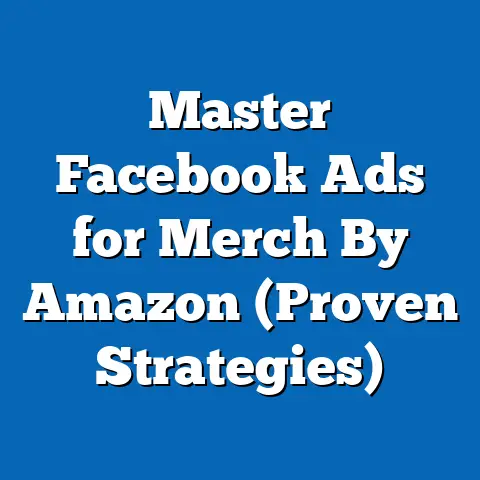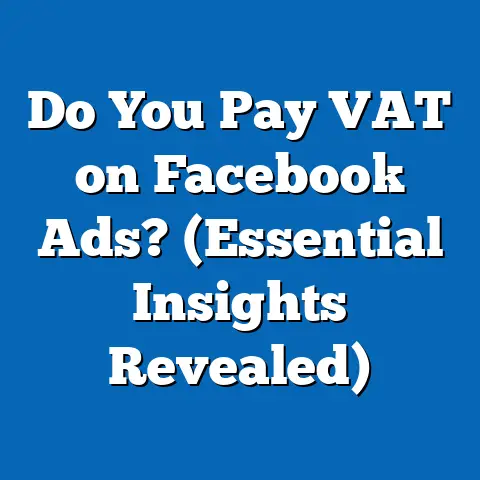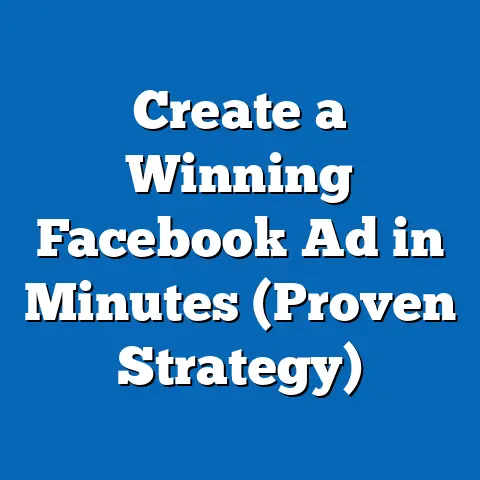Boosting Facebook Video Ads (Maximize Quality & Impact)
Have you ever felt the power of a story so deeply that it changed the way you saw the world? That’s the magic of video, and it’s why Facebook video ads are such a potent tool for businesses. I remember working with a local bakery that was struggling to stand out in a crowded market. They had delicious pastries, but no one seemed to notice. We created a short video showcasing the owner’s passion for baking, the care that went into each ingredient, and the joy their treats brought to the community. The response was incredible. Not only did their engagement skyrocket, but people lined up around the block to experience the bakery for themselves. This is just one example of how a well-crafted video ad can transform a business, and I’m here to guide you on how to maximize the quality and impact of your own Facebook video ads.
Understanding Facebook Video Ads
Facebook video ads are, simply put, video-based advertisements that run on the Facebook platform. They’re a powerful way to reach a massive audience and tell your brand’s story in a visually engaging way. Unlike static image ads, videos capture attention, convey complex information quickly, and evoke emotions that resonate with viewers.
There’s a diverse range of video ad formats available on Facebook, each designed for different placements and objectives:
- In-Stream Ads: These short, non-interruptive ads play before, during, or after other videos that users are watching.
- Stories Ads: Vertical videos that appear between users’ Stories, offering a full-screen, immersive experience.
- Feed Ads: Videos that appear directly in users’ news feeds, blending seamlessly with organic content.
- Carousel Ads: Feature multiple videos or images that users can swipe through, ideal for showcasing a product line or telling a multi-part story.
- Collection Ads: Visually driven ads that feature a hero video or image followed by related product images, designed to drive sales.
The advantages of using video ads over traditional image ads are significant. Studies have shown that video ads can generate higher engagement rates, leading to increased brand awareness and conversions. For instance, a study by HubSpot found that 54% of consumers want to see more video content from a brand or business they support. Furthermore, videos are more memorable than static images, helping your brand stick in the minds of potential customers. In my experience, I’ve seen video ads consistently outperform image ads in terms of click-through rates (CTR) and cost per acquisition (CPA).
Key Takeaway: Facebook video ads offer a powerful way to engage your audience, tell your story, and drive conversions. Understanding the different ad formats is crucial for selecting the right approach for your campaign goals.
Crafting High-Quality Video Content
Creating high-quality video content is paramount to the success of your Facebook video ads. It’s not enough to simply record a video; you need to ensure that it’s visually appealing, well-produced, and tells a compelling story.
Here are some key elements to consider:
- Resolution: Aim for a minimum resolution of 1080p (Full HD) for crisp, clear visuals.
- Lighting: Ensure adequate lighting to avoid dark or grainy footage. Natural light is often best, but artificial lighting can also work well if used correctly.
- Sound: Invest in a good microphone to capture clear audio. Background noise can be distracting and detract from the viewing experience.
- Editing: Use professional editing software to create a polished final product. Pay attention to pacing, transitions, and visual effects.
Storytelling is the heart of any successful video ad. Your video should tell a story that resonates with your target audience, evokes emotions, and leaves a lasting impression. Start by identifying the core message you want to convey and then develop a narrative that brings that message to life.
Here are some tips for effective storytelling:
- Understand Your Audience: Know their pain points, aspirations, and values.
- Create a Compelling Narrative: Structure your video with a clear beginning, middle, and end.
- Evoke Emotions: Use visuals, music, and voiceovers to create an emotional connection with viewers.
- Keep it Concise: Get to the point quickly and avoid unnecessary fluff.
Scripting and storyboarding are essential steps in the video creation process. A script outlines the dialogue and action in your video, while a storyboard visually maps out each scene. This helps ensure that your video is well-structured, cohesive, and delivers your message effectively. I’ve found that taking the time to plan out the video beforehand saves a lot of time and frustration during the editing process.
Branding is another critical aspect of video ad creation. Your brand should be recognizable throughout the video, but without being overly intrusive. Include your logo, brand colors, and tagline in a subtle and tasteful way. Make sure that your video’s message aligns with your brand values and reinforces your brand identity. I once worked with a client who created a beautiful video ad, but their branding was almost nonexistent. As a result, viewers enjoyed the video but didn’t associate it with the brand.
Key Takeaway: High-quality video content is essential for capturing attention and conveying your message effectively. Focus on resolution, lighting, sound, editing, storytelling, scripting, storyboarding, and branding to create a video that resonates with your audience.
Optimizing Video Ads for Facebook’s Algorithm
Facebook’s algorithm plays a significant role in determining the reach and performance of your video ads. Understanding how the algorithm works is crucial for optimizing your ads and maximizing their impact.
Here are some key factors that influence ad performance:
- Relevance Score: This metric measures how relevant your ad is to your target audience. A higher relevance score can lead to lower costs and better ad placement.
- Engagement Rate: This measures how engaged users are with your ad, including likes, comments, shares, and clicks.
- Video Completion Rate: This measures how many users watch your video until the end. A higher completion rate indicates that your video is engaging and relevant.
- Bidding Strategy: Your bidding strategy determines how much you’re willing to pay for each ad impression. Choosing the right bidding strategy can help you optimize your budget and achieve your campaign goals.
Video length is another important consideration. While there’s no one-size-fits-all answer, shorter videos tend to perform better on Facebook. Aim for a video length of 15-60 seconds for in-feed ads and 15 seconds or less for Stories ads. I’ve found that shorter videos are more likely to hold viewers’ attention and generate higher completion rates.
Thumbnails, titles, and descriptions are the first things that users see when they encounter your video ad. These elements should be attention-grabbing, informative, and relevant to your video’s content.
Here are some best practices:
- Thumbnails: Choose a visually appealing thumbnail that accurately represents your video. Avoid using generic or blurry images.
- Titles: Write a concise and compelling title that piques viewers’ curiosity and encourages them to click.
- Descriptions: Provide a brief summary of your video’s content and include a call to action.
Audience targeting is essential for reaching the right people with your video ads. Facebook offers a wide range of targeting options, including demographics, interests, behaviors, and custom audiences.
Here are some tips for effective audience targeting:
- Define Your Target Audience: Identify their demographics, interests, and behaviors.
- Use Custom Audiences: Upload your existing customer list or website visitors to create custom audiences.
- Create Lookalike Audiences: Expand your reach by targeting users who are similar to your existing customers.
- Test Different Targeting Options: Experiment with different targeting options to see what works best for your campaign.
I remember working with a client who was targeting a broad audience with their video ads. After refining their targeting options, we were able to significantly improve their ad performance and reduce their costs.
Key Takeaway: Optimizing your video ads for Facebook’s algorithm is crucial for maximizing their reach and impact. Pay attention to relevance score, engagement rate, video completion rate, bidding strategy, video length, thumbnails, titles, descriptions, and audience targeting.
Measuring Success and Making Adjustments
Measuring the success of your Facebook video ads is essential for understanding what’s working and what’s not. By tracking key performance indicators (KPIs), you can gain valuable insights into your audience’s behavior and make data-driven decisions to improve your campaigns.
Here are some essential KPIs to track:
- View Rate: This measures the percentage of users who watch your video. A higher view rate indicates that your video is engaging and relevant.
- Engagement Rate: This measures how engaged users are with your video, including likes, comments, shares, and clicks.
- Conversion Rate: This measures the percentage of users who take a desired action after watching your video, such as making a purchase or filling out a form.
- Cost Per View (CPV): This measures the cost of each video view. A lower CPV indicates that your ads are efficient and cost-effective.
- Return on Ad Spend (ROAS): This measures the revenue generated for every dollar spent on advertising. A higher ROAS indicates that your ads are profitable.
Facebook Insights and Ads Manager are powerful tools for tracking the success of your video ads. Facebook Insights provides detailed information about your audience, including their demographics, interests, and behaviors. Ads Manager allows you to track the performance of your ads in real-time, including impressions, reach, engagement, and conversions.
Here’s a step-by-step guide on how to analyze performance data:
- Log in to Facebook Ads Manager.
- Select the campaign you want to analyze.
- Click on the “Columns” dropdown menu and select “Customize Columns.”
- Choose the KPIs you want to track, such as view rate, engagement rate, conversion rate, CPV, and ROAS.
- Analyze the data to identify trends and patterns.
- Make adjustments to your campaign based on your findings.
Based on the data insights, you can make necessary adjustments to improve future campaigns. For example, if you notice that your view rate is low, you may need to improve your video’s thumbnail, title, or description. If your conversion rate is low, you may need to refine your targeting options or improve your call to action. I’ve seen clients transform their campaigns by simply paying attention to the data and making small adjustments along the way.
One great example is a local e-commerce company that was struggling to generate sales with their video ads. After analyzing their data, we discovered that their ads were performing well among younger audiences but not among older audiences. We adjusted their targeting options to focus on younger audiences, and their conversion rate skyrocketed.
Key Takeaway: Measuring the success of your video ads is essential for understanding what’s working and what’s not. Track key performance indicators, analyze performance data, and make necessary adjustments to improve future campaigns.
The Future of Video Advertising on Facebook
The landscape of video advertising is constantly evolving, and the future holds exciting possibilities for businesses looking to connect with their audience on Facebook. Artificial intelligence (AI) and machine learning are playing an increasingly important role in video ad creation and optimization. AI-powered tools can help you create personalized video ads, optimize your targeting options, and automate your bidding strategy.
Here are some potential future trends in the industry:
- Personalized Video Ads: AI can be used to create personalized video ads that are tailored to each individual user’s interests and preferences.
- Interactive Video Ads: These ads allow users to interact with the video content, such as by answering questions or making choices.
- Augmented Reality (AR) Video Ads: These ads overlay digital content onto the real world, creating immersive and engaging experiences.
- Livestreaming: Livestreaming is becoming increasingly popular, allowing businesses to connect with their audience in real-time.
To maintain relevance in your marketing efforts, it’s essential to embrace innovation and stay adaptable in your strategies. Experiment with new ad formats, targeting options, and creative approaches. Continuously monitor your performance data and make adjustments as needed. In my experience, the businesses that are most successful in the long run are those that are willing to experiment and adapt to change.
Video ads are a transformative tool for building connections and driving business success. By embracing innovation, staying adaptable, and focusing on quality and impact, you can unlock the full potential of Facebook video ads and achieve your marketing goals. The ability to tell a story, connect emotionally, and leave a lasting impression is what makes video so powerful. So, go out there, create compelling videos, and let your brand’s story shine on Facebook!





